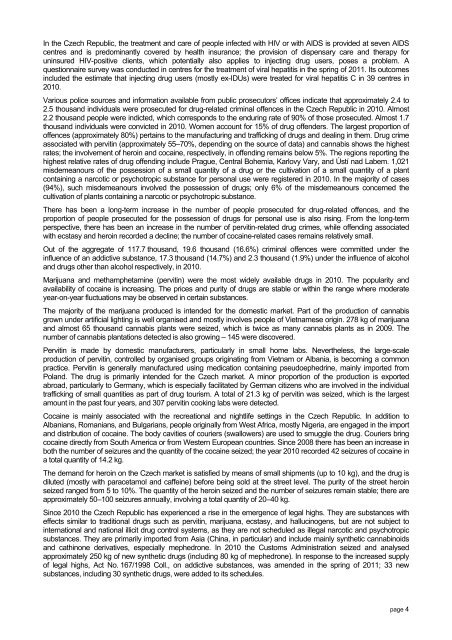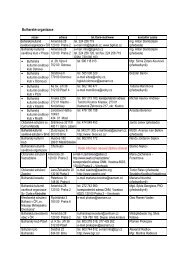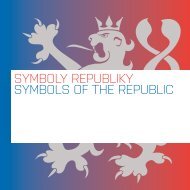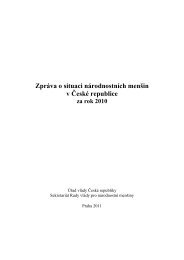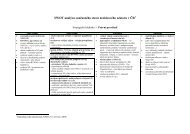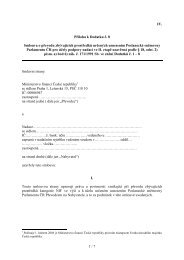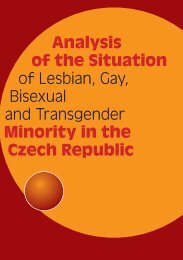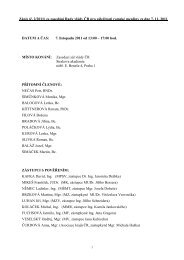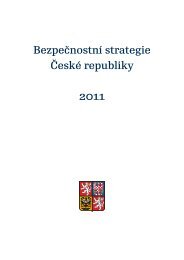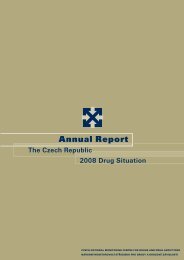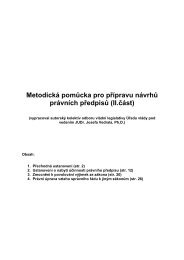The Czech Republic Annual Report 2010 Drug ... - Drogy-info.cz
The Czech Republic Annual Report 2010 Drug ... - Drogy-info.cz
The Czech Republic Annual Report 2010 Drug ... - Drogy-info.cz
You also want an ePaper? Increase the reach of your titles
YUMPU automatically turns print PDFs into web optimized ePapers that Google loves.
In the <strong>Czech</strong> <strong>Republic</strong>, the treatment and care of people infected with HIV or with AIDS is provided at seven AIDS<br />
centres and is predominantly covered by health insurance; the provision of dispensary care and therapy for<br />
uninsured HIV-positive clients, which potentially also applies to injecting drug users, poses a problem. A<br />
questionnaire survey was conducted in centres for the treatment of viral hepatitis in the spring of 2011. Its outcomes<br />
included the estimate that injecting drug users (mostly ex-IDUs) were treated for viral hepatitis C in 39 centres in<br />
<strong>2010</strong>.<br />
Various police sources and <strong>info</strong>rmation available from public prosecutors’ offices indicate that approximately 2.4 to<br />
2.5 thousand individuals were prosecuted for drug-related criminal offences in the <strong>Czech</strong> <strong>Republic</strong> in <strong>2010</strong>. Almost<br />
2.2 thousand people were indicted, which corresponds to the enduring rate of 90% of those prosecuted. Almost 1.7<br />
thousand individuals were convicted in <strong>2010</strong>. Women account for 15% of drug offenders. <strong>The</strong> largest proportion of<br />
offences (approximately 80%) pertains to the manufacturing and trafficking of drugs and dealing in them. <strong>Drug</strong> crime<br />
associated with pervitin (approximately 55–70%, depending on the source of data) and cannabis shows the highest<br />
rates; the involvement of heroin and cocaine, respectively, in offending remains below 5%. <strong>The</strong> regions reporting the<br />
highest relative rates of drug offending include Prague, Central Bohemia, Karlovy Vary, and Ústí nad Labem. 1,021<br />
misdemeanours of the possession of a small quantity of a drug or the cultivation of a small quantity of a plant<br />
containing a narcotic or psychotropic substance for personal use were registered in <strong>2010</strong>. In the majority of cases<br />
(94%), such misdemeanours involved the possession of drugs; only 6% of the misdemeanours concerned the<br />
cultivation of plants containing a narcotic or psychotropic substance.<br />
<strong>The</strong>re has been a long-term increase in the number of people prosecuted for drug-related offences, and the<br />
proportion of people prosecuted for the possession of drugs for personal use is also rising. From the long-term<br />
perspective, there has been an increase in the number of pervitin-related drug crimes, while offending associated<br />
with ecstasy and heroin recorded a decline; the number of cocaine-related cases remains relatively small.<br />
Out of the aggregate of 117.7 thousand, 19.6 thousand (16.6%) criminal offences were committed under the<br />
influence of an addictive substance, 17.3 thousand (14.7%) and 2.3 thousand (1.9%) under the influence of alcohol<br />
and drugs other than alcohol respectively, in <strong>2010</strong>.<br />
Marijuana and methamphetamine (pervitin) were the most widely available drugs in <strong>2010</strong>. <strong>The</strong> popularity and<br />
availability of cocaine is increasing. <strong>The</strong> prices and purity of drugs are stable or within the range where moderate<br />
year-on-year fluctuations may be observed in certain substances.<br />
<strong>The</strong> majority of the marijuana produced is intended for the domestic market. Part of the production of cannabis<br />
grown under artificial lighting is well organised and mostly involves people of Vietnamese origin. 278 kg of marijuana<br />
and almost 65 thousand cannabis plants were seized, which is twice as many cannabis plants as in 2009. <strong>The</strong><br />
number of cannabis plantations detected is also growing – 145 were discovered.<br />
Pervitin is made by domestic manufacturers, particularly in small home labs. Nevertheless, the large-scale<br />
production of pervitin, controlled by organised groups originating from Vietnam or Albania, is becoming a common<br />
practice. Pervitin is generally manufactured using medication containing pseudoephedrine, mainly imported from<br />
Poland. <strong>The</strong> drug is primarily intended for the <strong>Czech</strong> market. A minor proportion of the production is exported<br />
abroad, particularly to Germany, which is especially facilitated by German citizens who are involved in the individual<br />
trafficking of small quantities as part of drug tourism. A total of 21.3 kg of pervitin was seized, which is the largest<br />
amount in the past four years, and 307 pervitin cooking labs were detected.<br />
Cocaine is mainly associated with the recreational and nightlife settings in the <strong>Czech</strong> <strong>Republic</strong>. In addition to<br />
Albanians, Romanians, and Bulgarians, people originally from West Africa, mostly Nigeria, are engaged in the import<br />
and distribution of cocaine. <strong>The</strong> body cavities of couriers (swallowers) are used to smuggle the drug. Couriers bring<br />
cocaine directly from South America or from Western European countries. Since 2008 there has been an increase in<br />
both the number of seizures and the quantity of the cocaine seized; the year <strong>2010</strong> recorded 42 seizures of cocaine in<br />
a total quantity of 14.2 kg.<br />
<strong>The</strong> demand for heroin on the <strong>Czech</strong> market is satisfied by means of small shipments (up to 10 kg), and the drug is<br />
diluted (mostly with paracetamol and caffeine) before being sold at the street level. <strong>The</strong> purity of the street heroin<br />
seized ranged from 5 to 10%. <strong>The</strong> quantity of the heroin seized and the number of seizures remain stable; there are<br />
approximately 50–100 seizures annually, involving a total quantity of 20–40 kg.<br />
Since <strong>2010</strong> the <strong>Czech</strong> <strong>Republic</strong> has experienced a rise in the emergence of legal highs. <strong>The</strong>y are substances with<br />
effects similar to traditional drugs such as pervitin, marijuana, ecstasy, and hallucinogens, but are not subject to<br />
international and national illicit drug control systems, as they are not scheduled as illegal narcotic and psychotropic<br />
substances. <strong>The</strong>y are primarily imported from Asia (China, in particular) and include mainly synthetic cannabinoids<br />
and cathinone derivatives, especially mephedrone. In <strong>2010</strong> the Customs Administration seized and analysed<br />
approximately 250 kg of new synthetic drugs (including 80 kg of mephedrone). In response to the increased supply<br />
of legal highs, Act No. 167/1998 Coll., on addictive substances, was amended in the spring of 2011; 33 new<br />
substances, including 30 synthetic drugs, were added to its schedules.<br />
page 4


